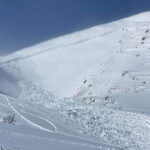Home »
Helping wildlife cross Highway 3 in Crowsnest Pass
Researchers from universities, government and conservation organizations have launched a new initiative to track grizzly bears, elk, and deer along Highway 3 in southwestern Alberta — a key wildlife corridor and a hotspot for animal-vehicle collisions.
Using satellite collars and remote cameras, the team is gathering data on how wildlife moves across the landscape to help inform new wildlife crossings along Highway 3, aimed at making the road safer for both animals and people.
Highway 3 is a busy road in southwest Alberta that runs through a beautiful valley where the Rocky Mountains meet the prairie. It connects the communities of Coleman, Blairmore, Frank, Hillcrest, and Bellevue — together known as the Crowsnest Pass — and is a popular route for both trucks and tourists between Alberta and British Columbia.
But this area is also home to important wildlife like grizzly bears, bighorn sheep, elk, and deer. The road can make it hard for these animals to move across the land, and it leads to animal-vehicle collisions that put both people and wildlife at risk.
To fix this, Alberta Transportation and Economic Corridors is building special wildlife crossings along Highway 3.
These include overpasses and underpasses that animals can use to safely cross the road, along with fencing, retrofitted culverts, and special escape ramps.
A similar system has been used along Highway 1 for many years and has reduced animal-vehicle collisions by over 80% and helped hundreds of thousands of animals move safely across the road.
Significant progress will be made on the Highway 3 mitigation system over the next five years so keep your eyes out for changes along the highway.
To make sure the new crossings work well, a group of researchers and organizations — including the Government of Alberta’s Ministry of Environment and Protected Areas, Biodiversity Pathways, Miistakis Institute, Nature Conservancy of Canada, University of British Columbia Okanagan and Yellowstone to Yukon Conservation Initiative — are working together to study wildlife movement.
So far, they’ve set up 80 motion-sensitive cameras and have fitted 20 elk, nine mule deer, and eight grizzly bears with satellite collars. These collars track how the animals move across the landscape, both day and night, and in different seasons. This information builds on prior work in the area and helps researchers understand how the new crossings affect animal movement — and will help make roads safer for everyone.
“ The Crowsnest Pass is home to some of the most iconic wildlife in the Rocky Mountains — from grizzly bears roaming the foothills to mule deer on seasonal migrations. But wildlife crossing Highway 3 can be dangerous for both animals and motorists. This investment in wildlife infrastructure is another world-class step forward for Alberta and were excited to roll out the science program alongside it. These animals will teach us a great deal about how to build safer roads and more connected landscapes,” stated Dr. Clayton Lamb, Wildlife Scientist, Biodiversity Pathways and University of British Columbia.
“Conserving land along the Elk Valley and Crowsnest Pass corridor is essential for sustaining healthy populations of the mountain wildlife we cherish, but it is only part of the solution. Building effective wildlife crossings is crucial to keeping conserved habitats connected and helping animals move safely across the landscape. We’re proud to be part of this important initiative, and we applaud the Government of Alberta for their strong commitment to tackling animal-vehicle collisions in the region,” said Tom Lynch-Staunton, Alberta Regional Vice President, Nature Conservancy of Canada.

“Our team in Fish and Wildlife Stewardship is proud to be partnering with Miistakis Institute, the University of British Columbia, Biodiversity Pathways, Nature Conservancy of Canada, and Yellowstone to Yukon Conservation Initiative, on improving connectivity of wildlife in Crowsnest Pass. This project provides an unprecedented opportunity to benefit wildlife in Alberta,” added Maria Didkowsky, Senior Wildlife Biologist, Government of Alberta.
This project is supported by funding generously provided by Parks Canada’s National Program for Ecological Corridors, Calgary Foundation, Wilburforce Foundation, Woodcock Foundation, and the Minister’s Special Licence Resident Draw Grants.
Reconnecting the Rockies Alberta is a multi-year research project aimed at understanding wildlife movement along a 56 kilometre stretch of the Highway 3 Transportation Corridor in the Canadian Rocky Mountains from Lundbreck, Alberta to the Alberta/British Columbia border.
Terrestrial large mammals in the region include grizzly bear, black bear, cougar, wolf, bighorn sheep, elk, moose, mule deer and white-tailed deer.
Animal vehicle collisions accounted for approximately 60% of the reported collisions on rural highways between 2015 and 2020.
Animal vehicle collisions cost Albertans approximately $300,000 a day in direct and indirect costs, including, property damage, health care, and highway cleanup.
We would like to acknowledge the generous in-kind contribution of staff expertise and equipment from the Government of Alberta.
Lead image: A moose pauses roadside at night, caught on one of the 80 motion-sensitive cameras. Photo submitted
Nature Conservancy of Canada







